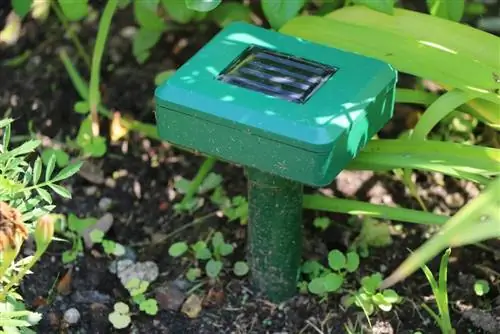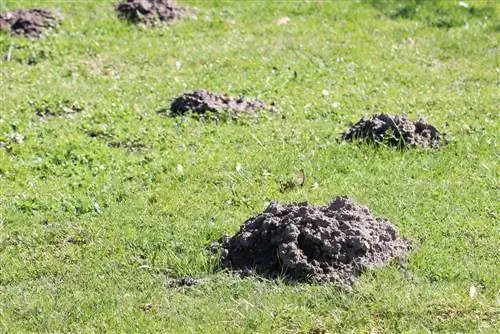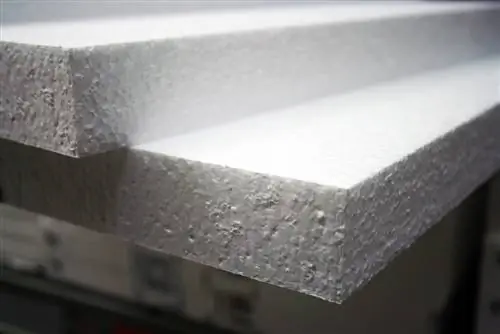- Author admin [email protected].
- Public 2023-12-17 03:39.
- Last modified 2025-01-24 12:45.
If molehills appear on your beloved lawn, there is often a lot of annoyance. The little animals are actually great helpers. Anyone who still wants to get rid of them often resorts to harsh tactics - without any notable success. It is certainly possible to remove the mounds and encourage moles to move. In a very simple way and at low prices. All you need is the right knowledge so that hobby gardeners can enjoy their green oasis without any problems.
Caution: Species protection and beneficial insects
The mole, or rather its ventilation holes - because molehills are nothing else - is usually viewed as a annoying fellow. But it must not be harmed because it is a protected species in Germany, Austria and Switzerland. The molehills must not be filled with water, surrounded with traps or even trampled flat. Simply put: no harm should happen to the resident, otherwise it can quickly become very expensive. In addition, a violation of species protection is also punished legally.
Apart from laws and pen alties, the mole itself is in no way harmful - quite the opposite. As they move through the soil, the animals ensure good aeration and mixing of the soil. Their main course is pests that could be dangerous for the garden. However, they do not attack plants themselves and can only slightly injure roots while they create their underground tunnels. Furthermore, the mole is also a seal of quality because it only settles in good soil. However, the mounds of earth can of course disturb the look. But this can easily be remedied.
Obstacles
If it constantly encounters obstacles while digging, the mole quickly loses interest in digging and looks for a new environment. Effective prevention can therefore be implemented when laying lawns and beds. Lawn edging stones, root barriers and mole barriers are inserted vertically into the ground and separate individual areas from each other underground. This requires a bit of effort, but it also keeps voles and other burrowing animals away. If the garden is frequently infested by these, the work and investment will quickly pay off. Especially since the measure only has to be carried out once and has no impact on your wallet or the environment.
Tip:
In areas that are still heavily dug up, several lawn edge stones or larger quarry stones can simply be buried and thus sunk, so that there is no visual disturbance on the meadow etc. The moles are still deterred by the obstacle course.
Sounds

Electronic devices that emit impulses or sounds are constantly appearing in stores. The stimulus, which is supposedly inaudible to humans, is intended to drive away moles or keep them away in the first place. That sounds simple and logical, but success is usually not achieved. There are also some disadvantages associated with such equipment. The vibrations emitted are by no means silent for everyone; younger people in particular, but also people with sensitive hearing and a tendency to migraines, quickly suffer from the high-pitched whistling. The garden therefore becomes a source of headaches rather than a place of peace and relaxation. In addition, the sound can be more than unpleasant for your own pets.
Moles and voles, on the other hand, are rarely really impressed by the technology and continue to dig happily. It is not uncommon for initial successes to be recorded, but after a period of getting used to the unwanted garden inhabitants usually come back.
Deterrence center
So-called mole deterrents are also available in stores, which are intended to disrupt the sensitive smell of the animals and thus encourage them to move. These are usually substrate-like substances that contain odors and are spread more or less widely in the garden. Into the ground, of course, which in turn means a significant amount of effort, because the grains or stones are distributed individually using a spade. This measure must be repeated several times a year if necessary or as a preventive measure. The workload and costs are comparatively high here.
It is often not even stated which odorous biocide the product is. So there is uncertainty when it comes to allergies, children playing in the garden and pets.
Home remedies
Moles don't see particularly well, but they can smell even better. Therefore, as already mentioned, they are sensitive to smells. This is exactly where home remedies for getting rid of moles can come into play. Intensely fragrant or smelly substances do not have to harm the human nose or he alth and certainly do not have to pollute the environment. Suitable means are:
- pressed garlic cloves or garlic oil
- Clove oil
- Patchouli oil
- Plant manure

Fermented dairy products and fish that have gone bad or spoiled meat are often recommended. However, other animals could be attracted with such means, while the plant scents themselves are more than uninteresting for cats, foxes, etc. In order to drive away the moles, it is better to use these. The procedure is as follows:
- Granules, cat litter or pulp are soaked in the smells. Alcohol can be added as an amplifier and preservation.
- The scent sources prepared in this way are inserted directly into the molehills, sprinkled on them or placed around them. If a hole is visible in the hill, they can also be placed in the passage below.
- If the passages are filled with “stench” in this way, the mole will soon run away. No more molehills are added. The soaked materials do not need to be removed as they pose no danger and will either spread or decompose over time.
- If the moles spread significantly, the odor sources should also be spread around the house and the hills. However, an escape path must remain clear so that the animals are specifically driven away by the smell and leave the garden in the desired direction.
Tip:
Once the moles have disappeared, obstacles should be integrated into the garden soil. This way the animals won't return even if the smell is gone.
Removing hills
The real nuisance is not the useful moles, but the molehills left behind. After the inhabitants of the underground passages have disappeared, they can be eliminated very quickly and easily. There are several possible measures for this.
- Removal with spade or shovel. The earth dug out can be used to fill flower pots, as a growing substrate or for demanding plants, as it is very loose and usually free of pests.
- Distribute with a rake or rake. The earth is spread until the hill is leveled with the ground. The plants in the area are happy about the high-quality substrate. In order to fill the possibly bare spot again, in the case of lawns, re-sowing must be carried out.
- Flush away with water. The molehills can be specifically removed and the soil distributed using a garden hose, watering can or bucket. This is a muddy affair, but also very simple and quick.
- Filling If the mole has disappeared, the molehills can definitely be leveled. The soil can be pounded flat or pushed back into the ground using pressure. On this occasion it makes sense to put a few larger stones or a mole barrier in the hole.
Molehills and garden care
If there are molehills on the lawn, the temptation is great to attack all the piles of dirt with the lawn mower after the small animals have been driven away. After all, the soil would also be distributed or end up directly in the lawn clippings - making work significantly easier. But this measure can quickly cause more damage than expected. When creating tunnels and air holes, moles often move stones to the surface, which are not always immediately visible but are more than noticeable when mowing. If they get caught in the cutting blades, it becomes dangerous for the blades and bystanders. At least a light spreading by hand or rake is therefore recommended before mowing the lawn.
Conclusion
If you introduce obstacles in the form of lawn edges or mole barriers and, if necessary, use simple but intense odorants, you can quickly drive away moles. Removing molehills is also easy and doesn't require much effort if you do it correctly.






